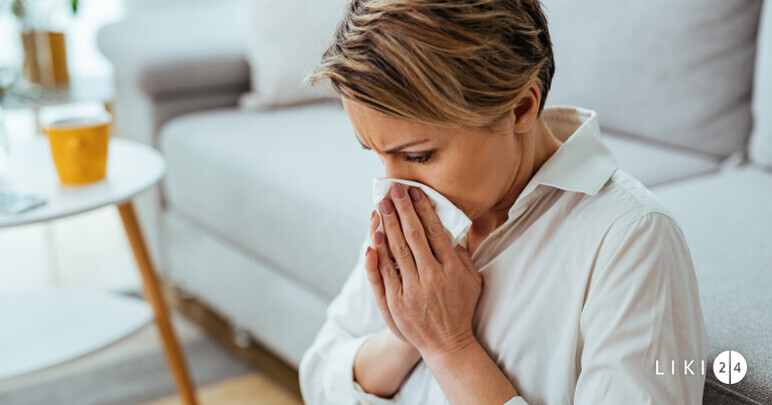L'influenza è un'infezione respiratoria molto più grave di un raffreddore. Le complicazioni dell'influenza, come l'encefalopatia e la polmonite, sono particolarmente caratteristiche delle persone non vaccinate e vulnerabili e possono portare anche alla morte. Le persone vulnerabili sono i bambini sotto i 5 anni, i neonati, gli adulti sopra i 65 anni, le persone con malattie croniche, le donne in gravidanza, le persone obese e gli operatori sanitari.
L'influenza e il raffreddore sono due delle infezioni respiratorie più comuni. I virus che causano il raffreddore e l'influenza sono altamente contagiosi e si trasmettono facilmente da persona a persona attraverso le secrezioni che si diffondono quando si tossisce, si starnutisce o si parla.
Anche se la malattia può presentarsi in qualsiasi momento dell'anno, anche in estate, i mesi freddi sono i più comuni per il raffreddore. Il motivo è che, a causa delle basse temperature, si sta di più in casa e in questo modo si è a più stretto contatto con gli altri.
Cause dell'influenza
In generale, l'influenza è causata da tre tipi di virus influenzali, A, B e C, che hanno diversi ceppi. Il virus dell'influenza di tipo C causa una forma più lieve di malattia e non provoca epidemie. Tuttavia, i virus influenzali di tipo A e B hanno ceppi virali multipli che portano a epidemie annuali. Di conseguenza, ogni anno viene prodotto un nuovo vaccino antinfluenzale che combina i ceppi più comunemente circolanti dei virus A e B. Per scoprire da quale ceppo di virus si è affetti, è possibile sottoporsi a un test influenzale.
L'organismo ha la capacità di produrre anticorpi contro i ceppi virali di cui ci si è ammalati. In questo modo, l'organismo può ridurre la gravità dei sintomi o prevenire una reinfezione con un ceppo virale simile a quello che si è ammalato.
Ma è importante sapere che i livelli di anticorpi diminuiscono nel corpo con il passare del tempo, quindi la principale misura preventiva è la vaccinazione regolare. I medici raccomandano la vaccinazione soprattutto per le persone vulnerabili.
Cause del raffreddore
Più di 200 virus possono essere gli agenti causali del raffreddore comune, ma nella maggior parte dei casi sono coinvolti i rinovirus. I coronavirus causano il raffreddore in misura minore. Gli esseri umani sono colpiti da un massimo di 6 ceppi di coronavirus, che possono causare sintomi da lievi a moderati di sindrome respiratoria acuta grave.
Altre possibili cause di raffreddore sono gli adenovirus, il virus respiratorio sinciziale e il virus parainfluenzale. Questi tre gruppi di virus possono causare sintomi insignificanti negli adulti e problemi piuttosto gravi negli anziani, nei bambini e in altre persone con un sistema immunitario compromesso. Le persone con asma, quelle con malattie polmonari o cardiovascolari, i neonati prematuri, hanno tutti un rischio maggiore di complicazioni come polmonite o bronchite.
Come si trasmettono il raffreddore e l'influenza?
Entrambi i raffreddori e le influenze si trasmettono in modo simile, attraverso starnuti, tosse o contatto diretto con superfici contaminate.
Il modo più semplice per trasmettere l'influenza e il raffreddore è da persona a persona, quando la distanza tra loro è inferiore a 1,8 metri. In genere il virus si trasmette principalmente attraverso il contatto con le goccioline contaminate di persone malate. Queste goccioline possono penetrare nel naso, nella bocca o essere inalate e raggiungere i polmoni.
La contagiosità delle persone malate dura fino a 3-4 giorni dall'inizio della malattia. Ma gli adulti sani che hanno contratto l'infezione possono trasmettere il virus fino a 5-7 giorni. Le persone con un sistema immunitario indebolito e i bambini possono trasmettere il virus anche più di 7 giorni dopo la comparsa dei sintomi.
La comparsa di raffreddore e influenza
Ci sono diverse differenze nell'insorgenza della malattia tra raffreddore e influenza. L'influenza ha un esordio violento e improvviso, con febbre a 39-40 gradi, brividi, stanchezza, tosse secca, dolore agli occhi, mal di testa e gola arrossata. Possono comparire anche debolezza generale, dolori muscolari e ossei. Esistono anche casi di influenza con vomito e nausea, eczema delle labbra o del naso, diarrea.
Se la paragoniamo al comune raffreddore, inizia con un lieve mal di testa, raucedine, starnuti, stanchezza, prurito al cuoio capelluto, mal di gola. In seguito si può verificare un aumento della consistenza del muco nasale, irritazione della cavità orale e un leggero pallore della pelle.
Sintomi di influenza e raffreddore
L'influenza inizia a manifestarsi circa 3 giorni dopo il contagio e di solito guarisce entro una settimana. I sintomi includono:
- dolore muscolare;
- Gelo improvviso di 38-40 gradi Celsius;
- Friggitelli;
- Oboseal;
- Forte sudorazione;
- tosse secca;
- Secrezioni nasali;
- Dolore alla gola;
- Dolore muscolare;
- Raramente, diarrea e vomito, soprattutto tra i sintomi dell'influenza nei bambini;
- perdita dell'appetito;
I sintomi del raffreddore sono:
- Secrezioni nasali compatte;
- Dolore alla gola;
- Non soffocante;
- Tosse;
- Diretto;
- occhi rossi;
- Lightweight;
- Cefalea da lieve a moderata.
I segni del raffreddore compaiono solitamente entro 2 giorni e migliorano dopo 8-10 giorni. Ma alcuni raffreddori possono durare fino a 3 settimane.
Trattamento di influenza e raffreddore
I rifugiati e l'influenza possono richiedere diversi tipi di trattamento, tra cui gli antibiotici non sono raccomandati. Solo su indicazione del medico di famiglia è possibile somministrare antibiotici anche per trattare le complicazioni che possono insorgere.
I migliori farmaci per il raffreddore e l'influenza si trovano qui sotto.
Come trattiamo l'influenza
È necessario iniziare il trattamento dell'influenza negli adulti e nei bambini bevendo liquidi (tè, acqua, zuppe calde) e riposando molto. Per il dolore si consigliano farmaci come Nurofen, Panadol, che può essere usato anche per trattare il raffreddore e l'influenza nei bambini, e Aspirin. L'assunzione di aspirina è sconsigliata agli adolescenti e soprattutto ai bambini perché aumenta il rischio di sindrome di Reye, una malattia rara e potenzialmente fatale.
Come trattiamo il raffreddore
Nel trattamento del raffreddore sono consigliati:
- Farmaci antinfiammatori e analgesici come Ibuprofene e Paracetamolo;
- Decongestionanti nasali come Xylo-nasal, Olynth, Rhinxyl. L'uso prolungato di questi prodotti può causare congestione nasale, per cui si consiglia un massimo di 5 giorni. Se ne sconsiglia l'uso ai bambini di età inferiore ai 6 anni.
- Sciroppo per la tosse come Coldtusin, Bronhosuport, Calmotusin.
Se si verificano complicazioni o l'infezione è grave, il medico può consigliare un farmaco antinfluenzale come oseltamivir, peravimir, zanamivir.
Tuttavia, è meglio evitare i farmaci contro il raffreddore e l'influenza che contengono lo stesso principio attivo per evitare un sovradosaggio.
Per accelerare la guarigione da raffreddore e influenza si consiglia di:
- Riposarsi - è meglio evitare che i bambini vadano a scuola e gli adulti al lavoro per ridurre il rischio di infettare gli altri. Inoltre si raccomanda di riposare a letto;
- Consumare più liquidi possibile: succhi di frutta, acqua, zuppe chiare. Evitate la caffeina e l'alcol perché disidratano;
- Regolare l'umidità e la temperatura della stanza: mantenere l'ambiente caldo, ma non bollente. Se l'aria è troppo secca, usate l'umidificatore. Un'umidità moderata aiuta a ridurre la tosse e la decongestione;
- Gurgitare per lenire il mal di gola;
Anche se esistono alcune somiglianze tra influenza e raffreddore, si tratta di due condizioni distinte, anche se colpiscono lo stesso tratto respiratorio. Mentre il raffreddore è più comune e ha meno probabilità di causare problemi, l'influenza ha un potenziale particolarmente pericoloso per i malati cronici, i bambini, le donne in gravidanza e gli anziani. In questo contesto, la vaccinazione antinfluenzale e il lavaggio delle mani possono aiutare a prevenire l'infezione.



 Benessere
Benessere  Fitness
Fitness  Nutrizione
Nutrizione  Bellezza
Bellezza  Benessere
Benessere  246 visualizzazioni
246 visualizzazioni 




 Articolo Precedente
Articolo Precedente 










